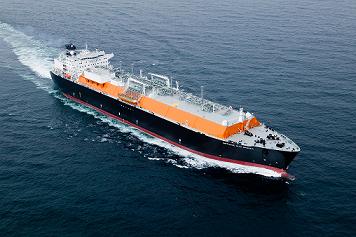
Fig:LNG carrier underway
Cargo handling equipment, testing instruments, automatic and other alarm systems should be maintained to a very high standard of efficiency at all times. Where electrical equipment is to be used in the cargo area it should be of approved design and `certified safe'. The safety of this equipment depends on maintenance of a high order which should be carried out only by competent persons. Unauthorised personnel should not interfere with such equipment. Any faults observed, such as loose or missing fastenings or covers, severe corrosion, cracked or broken lamp glasses etc should be reported immediately.
Work about the ship which might cause sparking or which involves heat should not be undertaken unless authorised after the work area has been tested and found gas-free, or its safety is otherwise assured.
Where any enclosed space has to be entered, appropriate precautions should be strictly observed. Dangerous gases may be released or leak from adjoining spaces while work is in progress and frequent testing of the atmosphere should be undertaken. `Permit-to-work' procedures should generally be adopted .
Related Information:
- Defining Various Liquefied Natural Gas Carriers
- How to tackle fire on board LNG ship
- LNG spill risk during marine transportation and hazards associated
- Fire fighting plan for LNG cargo
- LNG hazards & safety technology
Fuel flexibility of LNG ships
External links :
// Home page/// LNG handling /// LPG handling/// Sea transport /// Gas products///
Cargo work ///Fire precautions ///Health hazards ///Safety Precautions
///Emergency response ///
Copyright © Liquefied Gas Carrier.com All rights reserved.
The content published in this website are for general reference only. We have endeavoured to make the information as accurate as possible but cannot take responsibility for any errors. For latest information please visit www.imo.org . Any suggestions, please Contact us !
///Links &Resources // Terms of use/// Privacy policy///Home page///